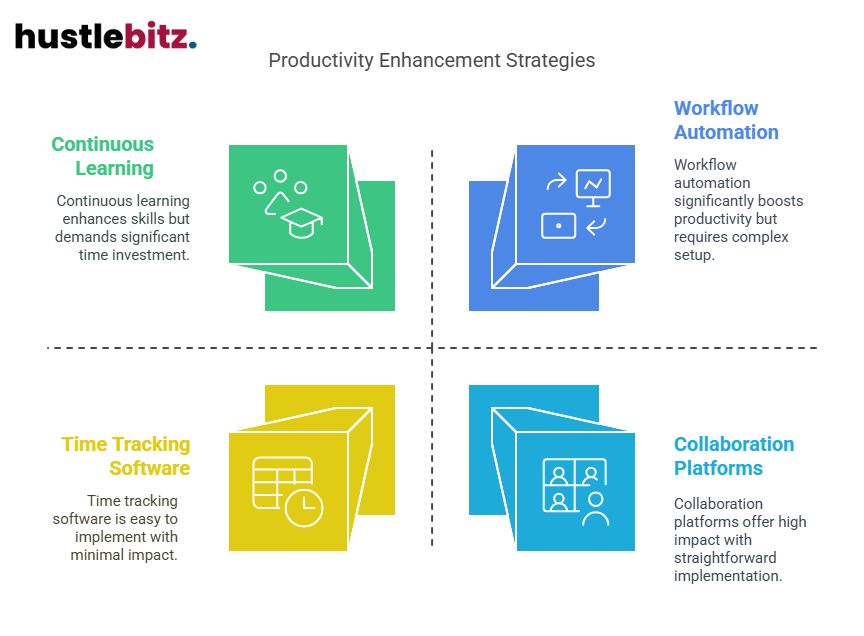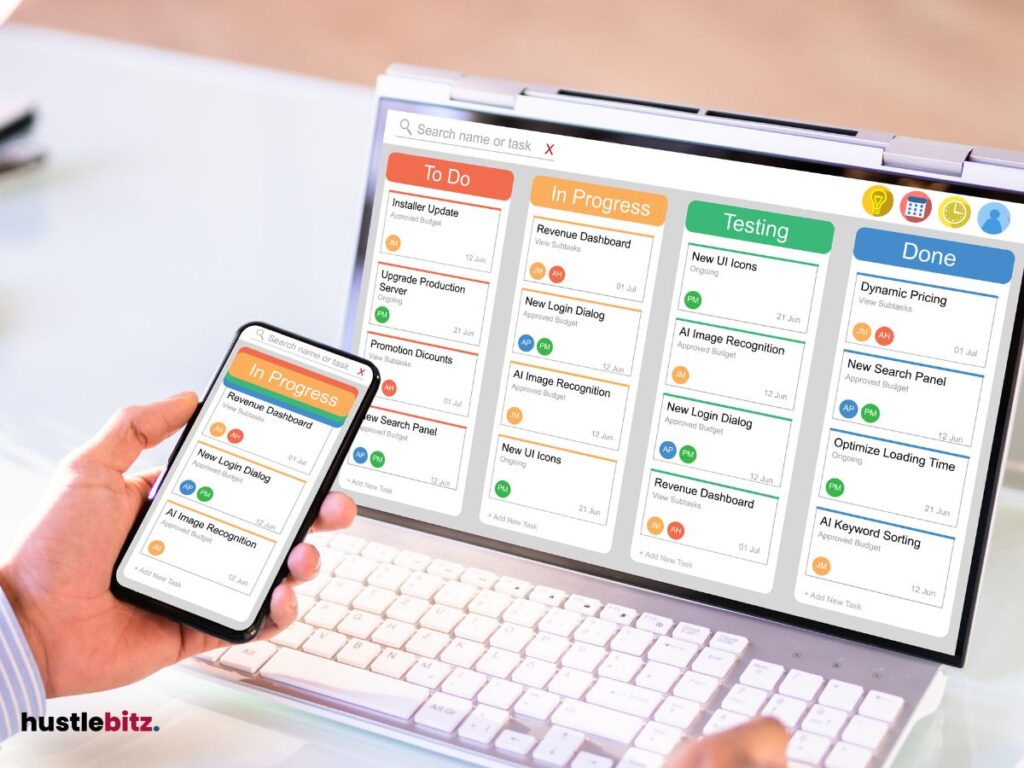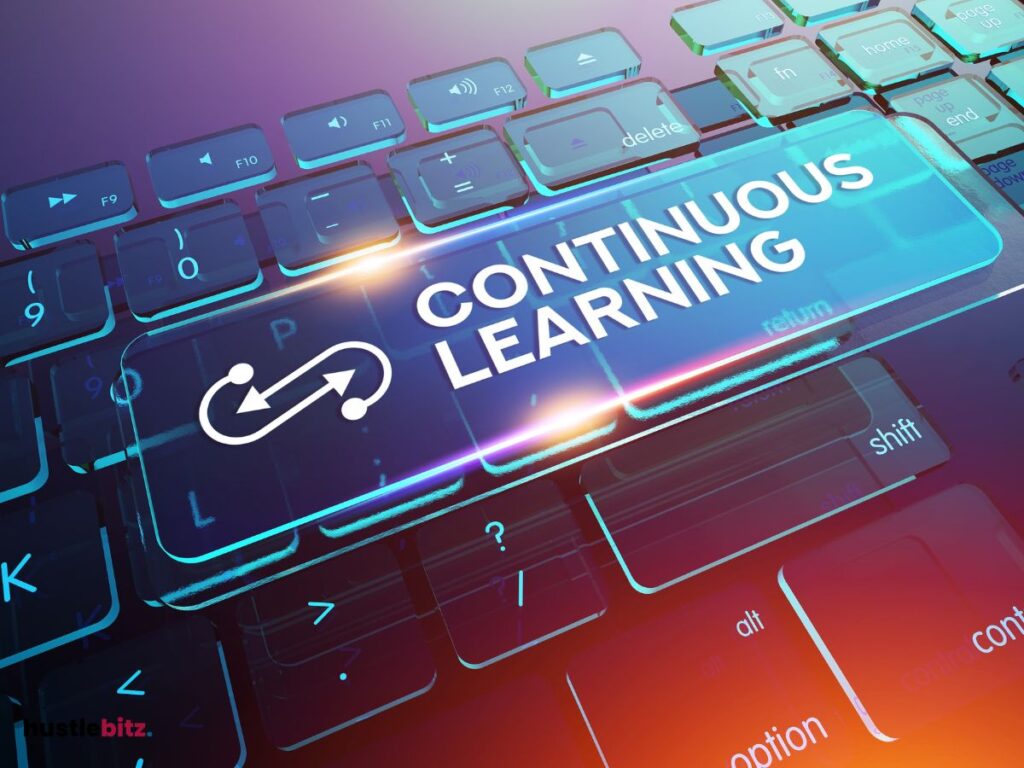Maximizing digital productivity involves leveraging a variety of tools and techniques to enhance efficiency and collaboration. Essential resources include time tracking software, workflow automation tools, and collaboration platforms that streamline communication. Task management software helps organize tasks effectively, while note-taking systems promote better information retrieval. Focus strategies, such as the Pomodoro Technique, can significantly enhance concentration and minimize distractions. Additionally, continuous learning resources, like online courses and webinars, facilitate skill development. To further explore these concepts and discover specific tools that can transform your productivity, continue on this journey of optimization.
Key Takeaways
- Utilize time tracking software to monitor time allocation and enhance decision-making for improved productivity.
- Implement workflow automation tools to reduce repetitive tasks and focus on high-impact activities.
- Leverage collaboration platforms for seamless communication and document sharing among remote teams.
- Adopt the Pomodoro Technique to maintain focus and manage time effectively through structured work sessions.
- Engage in continuous learning through online courses and webinars to enhance skills and adapt to changing demands.

Understanding Digital Productivity
Digital productivity refers to the effective use of technology and tools to enhance efficiency and output in work-related tasks, allowing individuals and teams to manage their time and resources more effectively. In today’s rapidly evolving work environment, understanding digital productivity is essential for fostering a culture of service and support among colleagues and clients alike.
Central to digital productivity are digital workflows, which streamline processes and minimize redundancies. By analyzing productivity metrics, teams can identify areas for improvement and implement efficiency strategies that promote better performance tracking. Goal setting plays a vital role in this context, as it provides a clear direction and motivation techniques that inspire individuals to strive for excellence.
In a landscape increasingly characterized by remote collaboration, the ability to engage in virtual teamwork becomes crucial. Techniques such as time blocking can help individuals allocate focused periods for tasks, ensuring that work-life balance is maintained while enhancing productivity. By prioritizing essential tasks and eliminating distractions, team members can contribute meaningfully to collective objectives.
Ultimately, understanding digital productivity is about more than just metrics; it is an ongoing commitment to nurturing both individual and collective growth. By leveraging technology effectively, teams can harness their potential, creating a supportive environment that encourages collaboration and shared success. Embracing these principles not only drives efficiency but also cultivates a workplace where everyone feels valued and empowered to serve others.
Essential Productivity Tools
What tools are indispensable for enhancing productivity in today’s fast-paced work environment? To effectively serve others and streamline operations, professionals must leverage essential productivity tools that address various aspects of their workflow.
Time tracking software plays a critical role in ensuring that individuals and teams are aware of how their time is allocated. This insight fosters better decision-making and prioritization. Complementing this, workflow automation tools minimize repetitive tasks, allowing team members to focus on high-impact activities that contribute to organizational goals.
Collaboration platforms enhance teamwork by providing spaces for real-time communication and document sharing, which is vital for maintaining project oversight. Effective communication tools, such as messaging apps and video conferencing solutions, further facilitate seamless interactions, especially in remote work environments where remote access is crucial.
Goal setting tools assist teams in defining clear objectives, while performance metrics applications enable them to measure progress and outcomes effectively. These tools help align individual efforts with broader organizational objectives, ensuring everyone is working towards the same mission.
Lastly, cloud storage solutions offer a reliable way to manage documents and files, enabling easy access and sharing across devices. Integration solutions that connect various tools into a cohesive system enhance efficiency and data flow, ultimately fostering an environment where productivity can thrive.
Task Management Software

Task management software is essential for organizing and prioritizing tasks, enabling teams to enhance their efficiency and meet deadlines effectively. By employing various task prioritization methods, such software allows users to identify high-impact activities and allocate resources accordingly. In collaborative environments, team collaboration platforms integrated with these tools foster seamless communication, ensuring that all members are aligned on project goals.
Utilizing project tracking tools, teams can monitor progress in real-time, applying time blocking techniques to allocate specific periods for focused work. This structured approach not only boosts productivity but also minimizes distractions, encouraging a disciplined workflow. Agile workflow systems further enhance adaptability, allowing teams to respond swiftly to changing priorities.
Gantt chart applications provide a visual representation of timelines, making it easier to manage deadlines and resource allocation. Complementing this, Kanban board strategies visually categorize tasks into stages, promoting clarity and transparency in the workflow. Effective deadline management software ensures that team members stay accountable, reducing the likelihood of missed deadlines.
For remote teams, robust remote work solutions are critical in maintaining productivity and collaboration. Many task management platforms also incorporate productivity analytics tools, offering insights that help improve team performance and identify areas for growth. By leveraging these features, organizations can create a culture of accountability and excellence, ultimately serving their clients and stakeholders more effectively.
Thus, investing in the right task management software is a vital step towards maximizing digital productivity.
Note-Taking and Organization

Effective note-taking and organization are crucial for capturing and retaining information, enabling individuals to streamline their thought processes and enhance overall productivity.
In an age where information overload is prevalent, leveraging digital notebooks and collaborative platforms can significantly aid in maintaining clarity and structure.
Utilizing advanced features within these tools can empower users to create organized and efficient notes. Consider the following strategies:
- Information Hierarchy: Structure your notes with clear headings and subheadings to facilitate easy navigation.
- Tagging Systems: Implement tags for quick categorization and retrieval of related topics, enhancing the discoverability of your notes.
- Searchable Archives: Maintain a digital repository that allows for swift searches, ensuring that critical information is always at your fingertips.
- Multimedia Integration: Enhance your notes with images, videos, or links to relevant resources, making the information richer and more engaging.
Moreover, utilizing cloud storage ensures that your notes are safely backed up and accessible across devices, thanks to cross-device syncing.
Additionally, annotation features allow for real-time collaboration, fostering teamwork and shared learning experiences.
Focus and Distraction Management

Managing focus and minimizing distractions are essential components for maximizing productivity in today’s fast-paced digital environment. Effective focus strategies can significantly enhance work output while ensuring a healthy work-life balance. By employing attention techniques such as the Pomodoro Technique, individuals can break their work into manageable intervals, reducing cognitive load and promoting sustained concentration.
To further combat distractions, consider implementing digital detox practices. A temporary withdrawal from digital devices can refresh the mind and promote mindfulness practices that foster a deeper connection with tasks at hand. Additionally, distraction blockers can be integrated into your digital ecosystem to limit interruptions from notifications or social media.
Environmental optimization also plays a pivotal role in focus management. Ensuring a clutter-free workspace and minimizing auditory distractions can lead to increased productivity. Incorporating productivity rituals, such as designated work hours and regular breaks, can help establish a rhythm that enhances focus.
| Focus Strategies | Distraction Blockers | Mindfulness Practices |
| Pomodoro Technique | Website blockers | Deep breathing exercises |
| Scheduled focus hours | App notifications off | Mindful walking |
| Decluttering workspace | Do Not Disturb mode | Meditation sessions |
Continuous Learning Resources

Continuous learning resources are essential for professionals seeking to enhance their skills and adapt to the ever-evolving demands of the digital landscape. By engaging with a diverse array of educational tools, individuals can cultivate their expertise, thereby better serving their teams and communities.
The following resources are particularly effective in supporting continuous skill development:
- Online courses: Platforms such as Coursera and Udemy offer a wide range of subjects, allowing individuals to learn at their own pace and gain certifications that validate their skills.
- Webinar series: Live sessions hosted by industry experts provide opportunities for real-time learning and interaction, fostering deeper understanding and networking potential.
- Podcast recommendations: Engaging with podcasts on relevant topics can enhance knowledge while accommodating a busy schedule, making learning accessible during commutes or exercise.
- Community forums: Participating in forums like Reddit or Stack Overflow encourages collaboration and the sharing of experiences, promoting a culture of collective growth.
In addition to these resources, e-learning platforms often feature video tutorials and educational blogs that cater to various learning styles.
Furthermore, mentorship opportunities can provide tailored guidance, enhancing personal and professional development.
Embracing these continuous learning avenues empowers professionals to not only keep pace with industry changes but also to inspire and uplift those around them.
Final Thoughts
Maximizing digital productivity requires the effective use of tools, techniques, and continuous learning to stay ahead in today’s fast-paced work environment. By embracing task management systems, focus strategies, and collaboration platforms, you can enhance efficiency, minimize distractions, and improve communication within your team. Furthermore, prioritizing ongoing learning ensures that your skills remain sharp and adaptable to the evolving demands of the digital landscape. Remember, productivity is an ongoing journey of optimization, and leveraging the right tools will help you stay on track and achieve your goals.




